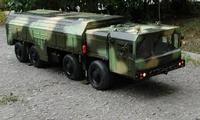Research and Markets: U.S. Military Tactical Vehicles Market: Focus to be on Leaner Operations and Niche Segments - Long-term Challenges Loom for Market Participants
DUBLIN--March 3, 2011: Research and Markets has announced the addition of Frost & Sullivan's new report "U.S. Military Tactical Vehicles Market" to their offering.
This research focuses on tactical vehicles. For the purpose of this research, The military vehicle market is split into four individual markets. Combat vehicles are defined as vehicles that are designed to close with the enemy. Self-propelled weapons, are vehicles such as self-propelled howitzers. Commercial vehicles are essentially identical to vehicles at local car or truck dealerships. Tactical vehicles are not designed to close with the enemy, but serve a support function to those that do. They are designed specifically for military purposes.
This Frost & Sullivan research service titled U.S. Military Tactical Vehicles Market provides sizes, forecasts, and trends applicable to the market. In this research, Frost & Sullivan's expert analysts thoroughly examine the following markets: light, medium, and heavy tactical vehicles and armored security vehicles.
Market Overview
Focus to be on Leaner Operations and Niche Segments
Eight years of tactical operations have changed the procurement and requirements for tactical vehicles. The previous assumptions of vehicle needs and specifications are no longer applicable, which is complicating the scenario for manufacturers. Now, vehicle manufacturers will need leaner operations and forays into niche markets to sustain growth. While market growth will be negative over the next five years, growth will occur in individual parts of the market, notes the analyst of this research. Notable in this area will be MRAP- All Terrain Vehicles (M-ATV), which will be the sustaining contract group.
Purchases of medium and heavy tactical vehicles are coming to an end. The large purchases of MRAP vehicles are complete, other than M-ATV. These vehicles are diminishing the need for a follow-on vehicle to the HMMWV (Humvee).
Long-term Challenges Loom for Market Participants
As the U.S. military forces trim procurements, the number of vehicle manufacturers with active contracts has declined to a handful. Vehicle manufacturers must look to the services and retrofit the market for any growth until the new designs are funded by the U.S. military. The large purchases of vehicles for operations in Iraq and Afghanistan have filled the militarys need for replacement vehicles. Budget constraints will limit replacement designs, cautions the analyst. Vehicle providers will suffer through the effects on these markets. Tactical vehicle production is likely to decline to 54 percent by 2011 and current program funding is not likely to restore funding authority until 2015. That will severely challenge vehicle manufacturers.
The current state of the equipment in operation will necessitate a reappraisal of funding after a force reset is complete. In general, new designs could offer opportunities, but the timing may be long. Joint light tactical vehicle (JLTV) may be one of the cost-saving losses and is almost guaranteed to be slowed from the original timelines, remarks the analyst. Rebuilds of HMMWVs on a selective basis and M-ATV will fill immediate needs.
Market Sectors
Expert Frost & Sullivan analysts thoroughly examine the following market sectors in this research:
- Light tactical vehicles
- Medium tactical vehicles
- Heavy tactical vehicles
- Armored security vehicles
Key Topics Covered:
1. Executive Summary
- 1.1 Introduction
- 1.2 Market Definitions and Scope
- 1.3 Study Background and Scope
- 1.4 Summary of Key Finding
- 1.5 Market Attractiveness
2. Military Tactical Vehicles Market Dynamics
- 2.1 Market Engineering Metrics
- 2.2 Industry Challenges
- 2.3 Market Drivers and Restraints
- 2.4 Analysis of Market Drivers
- 2.5 Analysis of Market Restraints
- 2.6 Analysis of Market Trends
- 2.7 Stakeholder Analysis
- 2.8 Competitive Overview
- 2.9 Competitive Assessment
- 2.10 Competitive Landscape
3. Military Tactical Vehicles Market Metrics
- 3.1 Procurement and Future Requirements by Service
- 3.2 Spending by Budget Category
- 3.3 Spending by Vehicle Type
- 3.4 Overall Spending Forecasts
For more information visit US Military Tact



